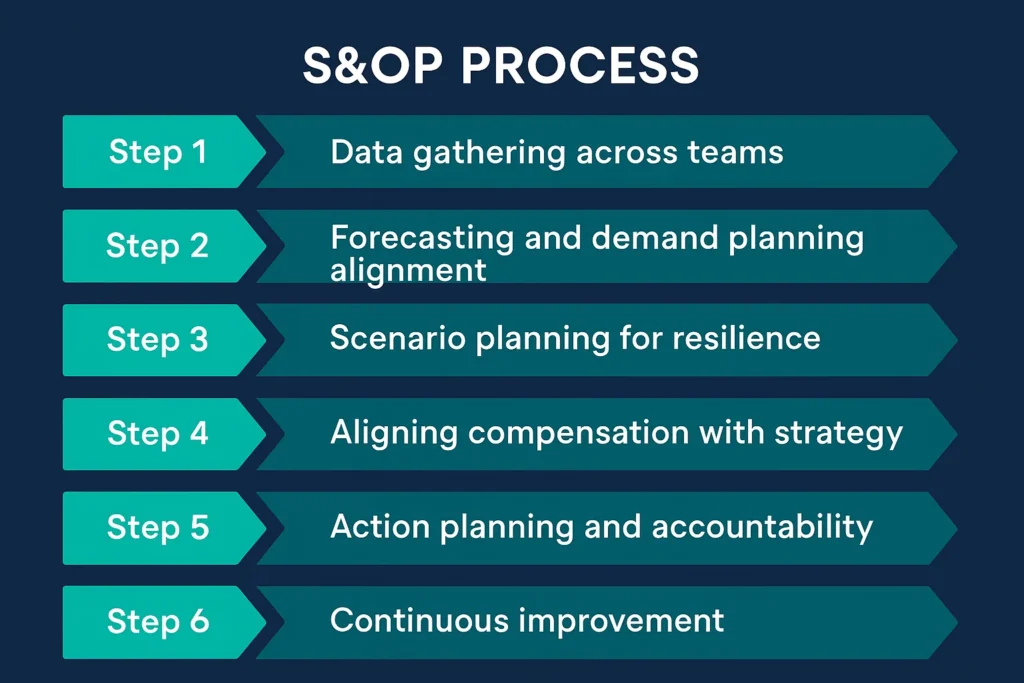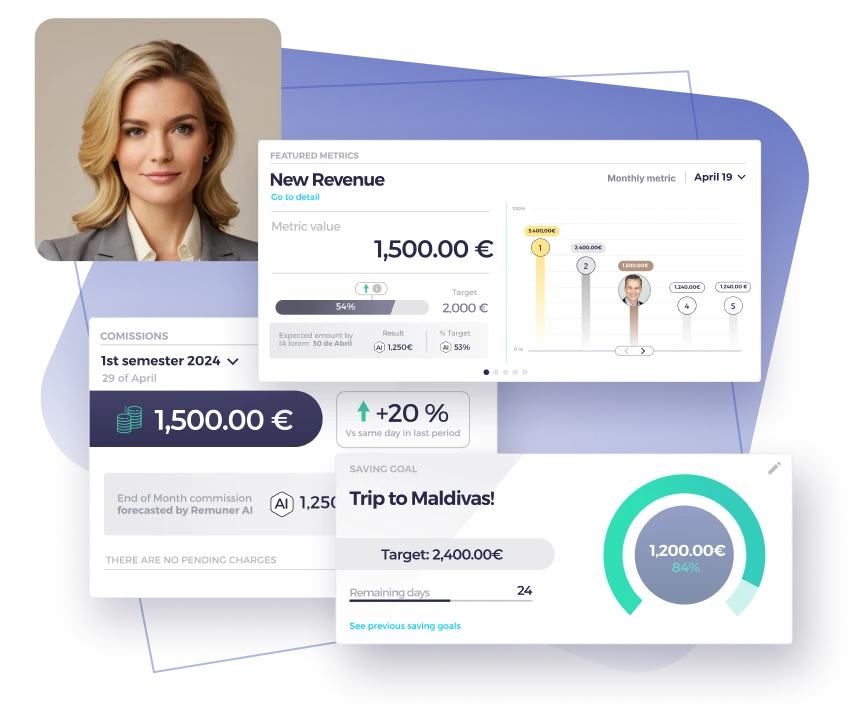Table of contents
What is sales operations planning?
Sales operations planning (often part of the broader S&OP process) is a cross-functional strategy that aligns your sales, demand planning, supply chain plans, and financial planning into a unified roadmap.
At its core, it balances demand forecasts with your production plan, workforce, and sales targets. It’s not just about spreadsheets—it’s about integrating people, processes, and tools for consistent growth.
Think of it as your company’s GPS system: It shows where you are, where you want to go, and how to course-correct if something changes.
Why sales operations planning matters
A well-run sales operations planning process delivers more than alignment. It enables:
- Accurate sales forecasts
- Stronger sales performance
- Better incentive alignment
- Increased customer satisfaction
- Faster decision-making
- Improved financial predictability
When sales and operations are disconnected, revenue suffers. Misaligned incentives, unrealistic quotas, and poor data gathering lead to burnout and missed targets.
Remuner helps solve this by automating incentive plans, tracking sales performance, and aligning compensation with real-time targets. Learn more about Remuner’s sales compensation tool by booking a free demo.
Key components of a sales operations plan
1. Sales Forecasting
You can’t plan if you can’t predict. Sales forecasting combines historical data, market trends, and rep performance to estimate future revenue.
Example: A SaaS company uses 12-month rolling forecasts, updated bi-weekly. Marketing provides campaign data, finance tracks ARR trends, and sales managers update deal progress—all feeding a centralized model.
How Remuner helps:
Remuner integrates with your CRM and revenue tools to turn forecasts into actionable quotas and compensation plans.
2. Quota and Territory Planning
This ensures every rep has a realistic target and access to the right accounts or regions.
Example: A B2B sales team assigns quotas based on historical deal size, market saturation, and new product potential, reviewed quarterly during S&OP meetings.
3. Sales Incentives and Compensation
Aligning compensation plans with strategic goals improves motivation and sales performance.
Example: You want to boost multi-product deals. Your incentive plan includes a commission multiplier for cross-sells. Reps now prioritize bundled offers.
How Remuner helps:
Build flexible, real-time compensation plans based on OTE, quota, and custom KPIs. Design your sales compensation plan.
4. Integrated Business Planning
Sales ops planning must connect to demand planning, supply planning, and financial planning.
Example: If demand forecasts show a spike next quarter, you might hire more reps now. If supply can’t keep up, you might shift incentives to other SKUs.
Integrated business planning (IBP) builds on the foundations of S&OP by connecting strategic goals with daily execution. Unlike traditional operations planning, IBP takes a broader, business-led approach that drives decision-making beyond just supply and demand. As Marcia Williams, Founder and Managing Partner of USM Spply Chain Consulting, points out in her Linkedin article S&OP vs. IBP: The War is Over, “The most profound difference between S&OP and IBP is that IBP is led by the business and focuses on strategy, not just operations.” This shift in focus makes sales a more active contributor—not just an output channel, but a driver of strategic planning.
The S&OP process: Sales as a driver
Traditionally, sales took a back seat in S&OP meetings, dominated by supply chain and finance. But in modern organizations, sales should drive the process—fueling decisions with market-facing insights and real-time feedback from the front lines.
Here’s how to make sales the core driver of your S&OP process, in six strategic steps:

Step 1: Data gathering across teams
Effective operations planning starts with clean, timely, and structured data. Sales teams must collect:
- Pipeline metrics
- Conversion rates by stage
- Win/loss reasons
- Customer feedback from the field
Marketing contributes campaign impact data, while finance brings actuals vs. targets. The key is integrating data across departments to create a unified view.
Remuner streamlines data gathering by connecting CRM, ERP, and compensation systems in one dashboard. Discover unified performance insights.
Step 2: Forecasting and demand planning alignment
Sales forecasts influence everything—from production to staffing to delivery. But if sales forecasts diverge from demand planning, it leads to either excess inventory or unfulfilled demand.
Align these teams by running joint forecasting sessions. Encourage sales and operations to reconcile differences using shared assumptions and scenario modeling.
This ensures accurate demand forecasts, smoother supply chain plans, and a more agile business.
Step 3: Scenario planning for resilience
The market changes fast. Scenario planning equips your team to respond proactively rather than reactively.
Example scenarios to prepare for:
- A sudden surge in demand
- Loss of a key account
- Supply disruptions
- Sales underperformance in a key region
Each scenario should include a response strategy: shift incentives, reassign territories, adjust production levels, or revise quotas.
With Remuner, you can simulate incentive plan changes to see their impact before rolling them out. Run compensation simulations.
Step 4: Aligning compensation with strategy
Your incentive plans should support—not contradict—your strategy. Too often, reps chase low-margin deals or short-term wins because the comp plan nudges them that way.
During your S&OP meeting, evaluate:
- Is OTE aligned with quota and product priorities?
- Are incentives motivating desired behaviors (e.g. new logos, upsells)?
- Are rewards balanced across teams and territories?
If the answer is no, it’s time to revise your plan. Remuner lets you deploy new commission structures in days, not months.
Step 5: Action planning and accountability
Planning without execution is just a spreadsheet. Every S&OP meeting must end with an action plan:
- What are the next steps?
- Who owns each one?
- What’s the deadline?
- How will progress be tracked?
Sales, finance, and operations should co-sign the plan. Shared accountability reduces finger-pointing and speeds up decision-making.
Step 6: Continuous improvement
Sales operations planning is not a “set it and forget it” system. Review performance monthly or quarterly and evolve the process:
- What worked last cycle?
- Where were we over/under-forecasted?
- Did our incentives drive the right behaviors?
- Did we meet customer satisfaction goals?
Use each S&OP meeting to refine strategy, improve customer service, and increase predictability. This keeps your business agile and performance-driven.
Sales plays a larger role when businesses shift from siloed planning to integrated business planning (IBP). As McKinsey notes, “IBP provides a single version of the truth and a clear view of the road ahead—improving service levels, working-capital efficiency, and profitability.” With sales data feeding directly into broader supply and financial plans, incentive strategies become smarter, and performance improves across the board.
Sales operations planning examples
Example 1: Enterprise tech company
Challenge: Incentive plans were too complex and disconnected from revenue strategy.
Solution: The company revamped its sales operations planning by linking its commission tracking software with quota planning and CRM data. With Remuner, they moved to real-time dashboards.
Result:
- Commission errors dropped by 90%
- Sales performance rose by 18%
- Time spent on comp plan admin decreased by 60%
Example 2: Consumer goods brand
Challenge: Forecasting was inaccurate, and supply often couldn’t meet demand.
Solution: By integrating demand forecasts with sales goals, finance, and supply chain data, the team built an agile S&OP process.
Result:
- 15% higher forecast accuracy
- 25% improvement in order fulfillment
- Cross-functional alignment improved dramatically
How to measure the impact of your sales operations planning
Look at these metrics to evaluate performance:
- Quota attainment rate
- Sales performance by rep or team
- Incentive cost as a % of revenue
- Forecast accuracy
- Cycle time from plan to payout
- Commission disputes and corrections
Remuner simplifies this with built-in analytics that track plan effectiveness and payout trends. Explore commission analytics.
FAQ: Sales operations planning
What is the difference between S&OP and sales operations planning?
S&OP is a broader framework that aligns supply, demand, and finance. Sales operations planning focuses specifically on how sales forecasting, incentives, and performance tracking integrate into that process.
How do compensation plans impact sales forecasting?
If incentives push reps to close high-volume deals at quarter-end, forecasts can become skewed. Balanced compensation plans lead to more predictable performance and accurate forecasting.
Why is scenario planning important in sales operations planning?
It prepares your team for rapid shifts in market conditions. Scenario planning ensures you’re ready to adjust quotas, incentives, and supply chain plans without disrupting revenue.
How does Remuner support sales operations planning?
Remuner connects sales compensation, quota setting, performance tracking, and commission automation in one platform—making it easier to align strategy with execution.





